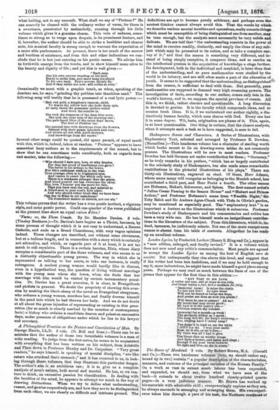The Races of Mankind. 2 vols. By Robert Brown, M.A.
(Cassell and Co.)—These two handsome volumes (four, we should rather say, bound up in two) contain "a popular description of the characteristics, manners, and customs of the principal varieties of the Haman Family.' On a work so vast in extent much labour has been expended, and expended, we should say, from what we have seen of the book—it extends to about twelve hundred closely-printed quarto pages—in a very judicious manner. Mr. Brown has worked up his materials with admirable skill ; overpoweringly copious as they are, he always succeeds in managing and arranging them. His ownexperi- ence takes him through a part of his task, the Northern continent of
America, especially ; but he has, of course, also had to lay many writers under contribution, a task of discrimination and selection not by any means easy. To pass a judgment on the subject-matter of the work, or to compare, as regards interest and value, its various parts, is more than our criticism can pretend to do. Perhaps the part that creates the most profound feeling of astonishment is the earlier portion (extending to about 200 pages, or two-thirds of the whole) of the third volume, which deals with the manners and customs of the African tribes. There is nothing probably that a diligent student of the many books of African travel published during the last twenty years may not have seen before, but the effect of the whole mass of these details, so grotesque and so horrible, when thus brought together, is simply overpowering. The elajoration of these monstrous conventionalities is especially surprising. A complete civilisation, one may say, might have been developed by th'e expenditure of thought and labour which has been employed in building up this hideous, ludicrous fabric of savagery. The first volume contains an account of the American tribes, north and south. The second, after a brief sketch of society in the Spanish States of South America, deals with the Polynesian, the Papuan, and the Malay tribes, and then proceeds to the inhabitants of Southern Africa. The contents of the third we have indicated already, except as regards its latter half. This has a remarkably interesting chapter on "The Decay of Wild Races." Here it is satisfactory to note what can be done in the way of preserva- tion by a scrupulous policy on the part of a superior race. The Esquimanx of Greenland have increased fifty per cent, during the last half-century. One notable fact is that the sale of spirits is absolutely forbidden by the Danish Government. Were it allowed—so disastrous is their effect when any chance throws them in the way of the people— the Esquimaux would probably have disappeared by this time. The rest of the volume is devoted to the minor Asiatic races. The fourth treats of India on either side of the Ganges, the Chinese, and the Tartars. The volumes are illustrated with a profusion of excellent engravings.































 Previous page
Previous page